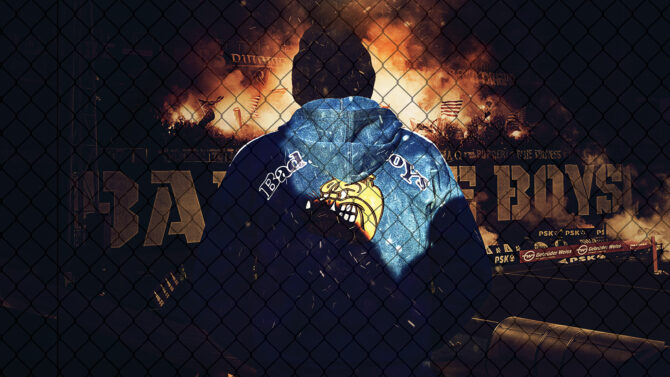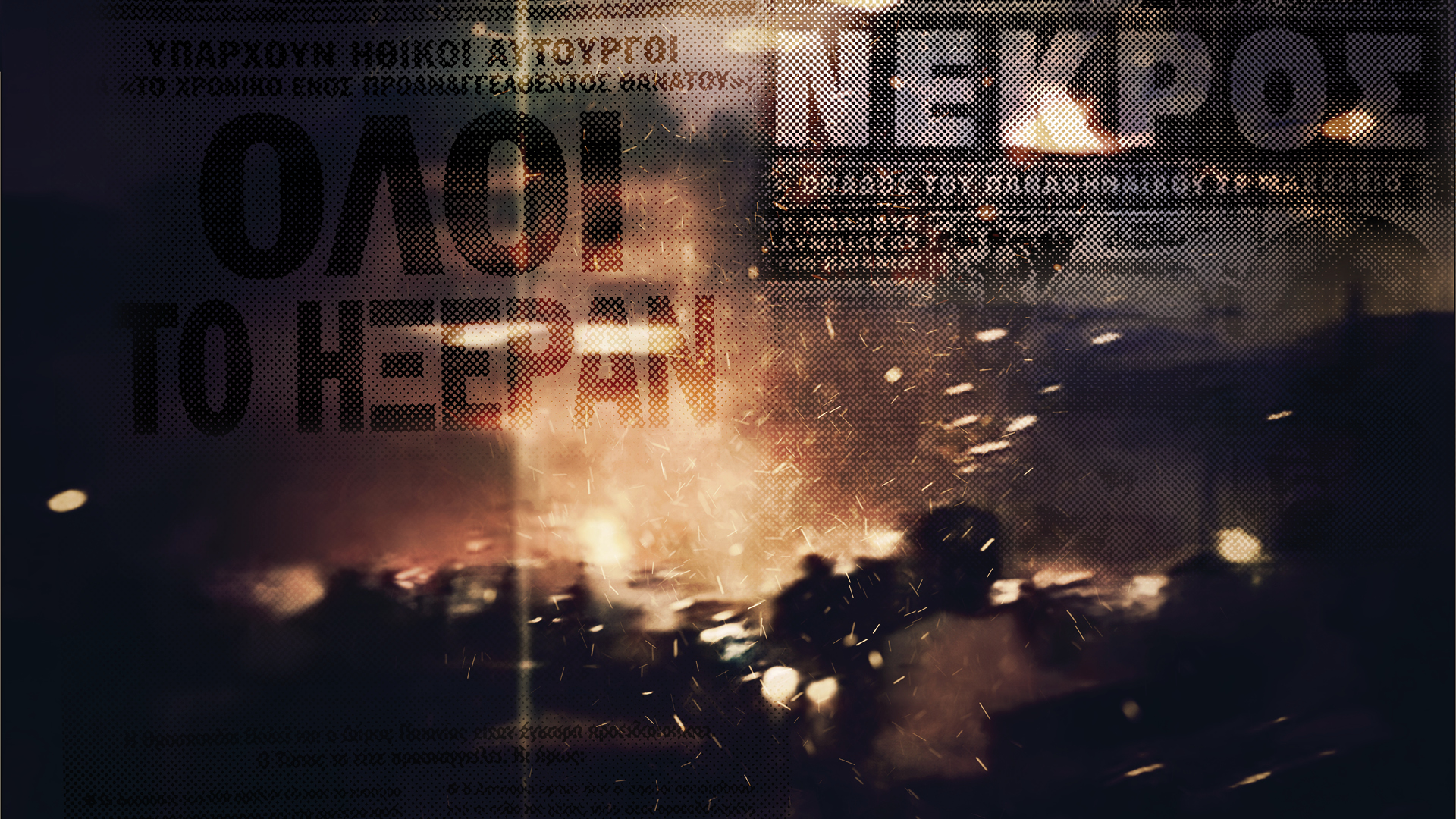“For the first time, we understood how our opponents think” – a video that endures till this day marked the onset of a new, more aggressive era of hooliganism in Greece.
In the room with the Bad Blue Boys

iMEdD met in Zagreb with leading members of one of the most hardcore Ultras groups in Europe.
On March 29, 2007, in the post-match aftermath of a women’s volleyball encounter between Olympiakos and Panathinaikos, an event that would become a grim milestone for fan violence in Greece unfolded: the fatal stabbing of 22-year-old Panathinaikos supporter Michalis Filopoulos during the clashes on Lavriou Avenue preceding the match.
The fight between the fans was pre-arranged. Hundreds from both sides traversed various distances across Athens, riding on motorbikes with insignias removed, arriving at the scene of confrontation—accounts from contemporary press reports and subsequent trial testimonies attest to this. Clad in black attire and donning helmets (some even wearing bulletproof vests), they were armed to the teeth with ballistic knives, stun grenades, naval flares, kryptonite chains, and an assortment of knives of varying sizes.
The supposed agreement was that knives shouldn’t target above the thighs. However, it wasn’t followed, which makes one question its feasibility given the ferocity of the conflict. It’s worth noting that the volleyball federation, the municipality of Peania, and media reports had issued early warnings about the impending clash, yet authorities took no action to prevent the ensuing chaos.
“That’s when the fan movement got ruined. After that, it was all stabbings,” and “tensions were skyrocketing.” These are some of the quotes used by the people we spoke to during our month-long investigation into fan violence. The consensus was clear: it marked a significant turning point – fan violence in Greece is now demarcated by the period before and after the murder of Filopoulos.
That’s when the fan movement got ruined. After that, it was all stabbings, tensions were skyrocketing
The incident sparked nationwide outrage, leading to the paralysis of professional sports with the suspension of sporting activities for several weeks. Amidst grandiose rhetoric and promises of significant measures, which, as usual, remained largely unimplemented, nine individuals were charged with murder. Eventually, four were found guilty, receiving sentences ranging from 10 to 16 years. (Notably, among the accused were the current vice-president of Olympiakos FC and at least two later security officers at the Georgios Karaiskakis stadium.)
However, what remained unknown to the general public was that prior to the “fatal rendezvous” — as pre-arranged brawls are termed in Greek — on Lavriou Avenue, a similar altercation had unfolded in the Pangrati neighbourhood, specifically on Ymittou Avenue. A fan who had been present at both clashes provided insights into the Ymittou confrontation. “At that time, Panathinaikos fans, though divided between independent associations and Athens Fans, came together to confront Olympiakos fans in this brawl because the Olympiakos association in Pangrati was exceptionally strong. So there was this particular aspect during the preparations for the clash.”
The outcome was a clash of comparable ferocity, setting the stage for the fateful “rematch” 14 months later. The events on Ymittou Avenue attained legendary status in fan narratives on message boards and YouTube comments. Fortunately, thanks to a video, we can glean a relatively accurate picture of the incident (available for viewing on the YouTube channel of Michalis’ father, Andreas Filopoulos). The footage was captured by Russian Spartak Moscow fans who had travelled to Greece to support their allied Olympiakos fans in the fight.
Saturday, January 14, 2006. The Russians’ video begins with their landing at Eleftherios Venizelos airport, where they are greeted by Greeks. There are at least five of them, travelling in two cars to hotels booked in the centre of Athens, situated across from each other. They appear cheerful, constantly joking, giving the impression of being on a leisure trip. They proudly hang the Spartak Moscow flag from their room window and take pictures with their camera, some showing them posing in a Nazi salute. At one point, we hear their Greek escorts mention plans to pick them up at 3:30 pm. Indeed, in the next frames, we see them having coffee and getting acquainted with the leaders of their Greek “brother” supporters.
They then gather at the church of Prophet Elias on Ymittou Avenue. There, they collect ammunition including machetes, crowbars, bottles, stones, pieces of slabs, and curb, continuing to have fun, even re-enacting the scene from A Clockwork Orange where the gang of “droogs” sings “Singin’ in the Rain”. As they descend Ymittou Avenue, near the back wall of the First Cemetery of Athens, the clash with the Panathinaikos fans occurs. While the camera continues recording, it struggles to focus amidst the chaos of objects and flares being thrown, followed by hand-to-hand fighting.
In fan lore, it is believed that “Panathinaikos fans came out on top in the scrap.” This was the first time a fan conflict had been captured from an insider’s perspective, accessible to many. In addition to the hand-to-hand combat, Panathinaikos hooligans seized the Russians’ camera and proudly leaked the video online. It didn’t take long for the media to catch wind of it; the Ymittou brawl quickly went viral, as we’d describe it today.
It was almost impossible to identify anyone on Lavriou Avenue, the way they were all covered from head to toe
A quirky mix of new technology and the emerging media landscape of the time (YouTube had just launched in 2005) set a precedent that pushed hooliganism to the next level. It wasn’t just about winning the fight anymore; it was about being able to post it online. And there was something else too, as the fan present at the fight in Pangrati explains: “For the first time, one side understood how the opponents were thinking, what they were discussing, and how they were fighting because of the video.”
The next “showdown” was in the works for months. “I don’t think Filopoulos was targeted, he was just the one who got caught. Besides, it was almost impossible to identify anyone on Lavriou Avenue, the way they were all covered from head to toe,” says our source. It was only a matter of time before the big shots organised the clash on Lavriou Avenue. The former wanted to reclaim their lost “prestige,” while the latter aimed to confirm their “dominance.”
With that, a new, fiercer, and more ruthless era of hooliganism in Greece had dawned.
Listen to all episodes of the audio documentary Hooligan Express here
